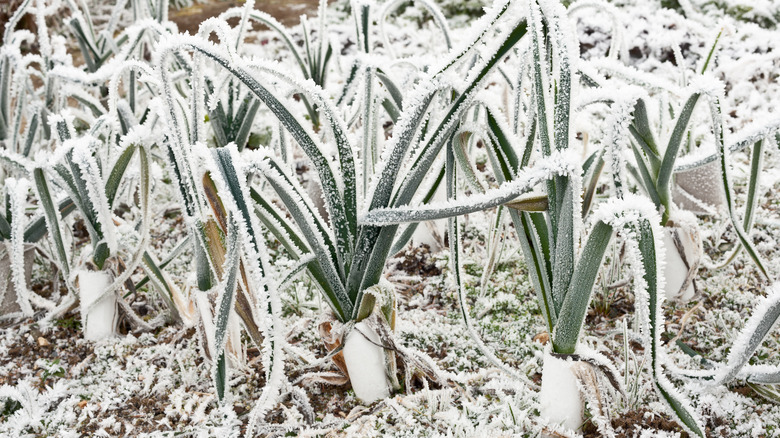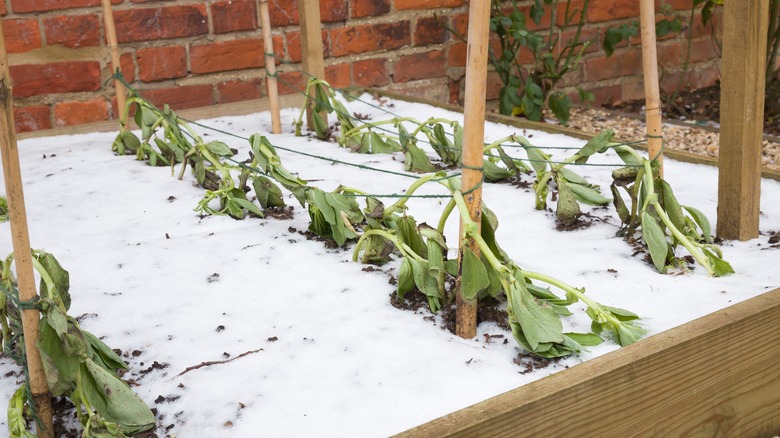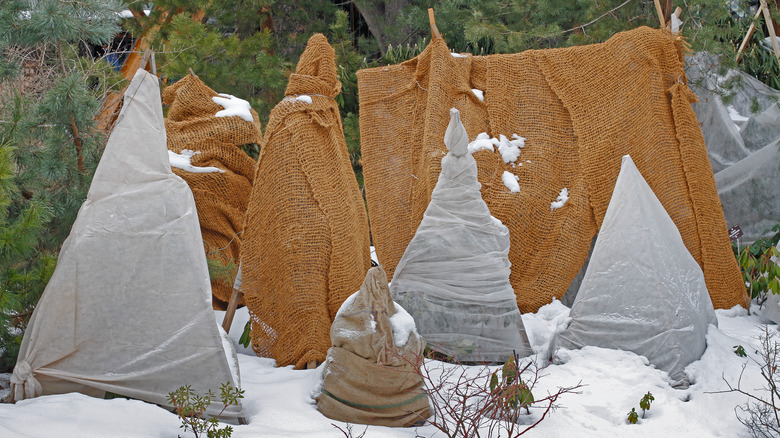Why You Should Keep A Jug Of Hot Water Near Your Plants In Chilly Temperatures
While winter is characterized by consistent cold weather, the end of fall and beginning of spring are often marked by temperature ups and downs. The first frost or freeze of autumn can be followed by weeks of warmer weather, and the spring thaw can be followed by a few more freezes. These low temperatures, as well as the temperature swings, are stressful for plants, many of which can be injured or killed by a cold snap. Luckily, it's easy to keep your plants warm with a few items you probably have on hand — like a milk jug and some hot water.
The best way to protect plants from low temperatures is to cover them with cloth, plastic film, or even a cardboard box to trap heat. If you're afraid this won't be enough to keep your plant alive through a deep freeze, you can add some extra heat by placing a jug of hot water underneath your plant's covering. The water will cool overnight and release heat, which will be trapped by the cover. This hack may be a better option than using a heater or lightbulbs to keep your plants warm in cold weather. While these options can be effective, they use up electricity and come with the risk of starting fires or not working properly. Instead, simply and affordably add heat around your outdoor plants by using an old milk jug in your yard.
Why cold harms plants
Plants store water in their cells, and water expands when it freezes, developing sharp edges that can damage cell walls. Many plants are susceptible to cold damage, including fruits, vegetables, tropical plants, and young seedlings. Hardy perennials undergo hormonal changes in order to survive harsh winters, but sudden temperature swings can catch them off-guard. An early autumn freeze can send fruiting plants into dormancy weeks before the harvest should end. After plants start to emerge from their winter hibernation, a late freeze can hurt or even kill them before the growing season begins.
Container plants are extra vulnerable because they don't have the benefit of ground soil to insulate their roots. Ground soil retains a lot of heat, allowing it to stay warmer than the air above it — but the soil in a container will get almost as cold as the air temperature. This can damage the plant's tender roots. It may be enough to move container plants to higher ground, like a bench or table, where the air is warmer. You could also bring small ones indoors during the cold snap. But what if your containers are too big to move, or you have cold-sensitive plants in the ground? These plants will appreciate a jug of hot water.
How to use this trick
For plants that can't be moved, covering them from the ground up is the best protection. As the air cools and the soil starts to release its stored heat, the covering traps the heat around the plant. You can buy a lightweight plant cover material at any home improvement store — or, in a pinch, you can use boxes, buckets, blankets, or trash bags. But blankets are heavy and cold plastic can burn plants, so use supports to keep these materials from touching the plant directly. However, if a deep freeze is in the forecast, covering plants from frost may not be enough. This is when placing a milk jug filled with hot water inside the covering will benefit your plants.
Water has a high heat capacity, meaning it must absorb a lot of heat before its temperature starts to rise. You can harness all the heat stored in hot water to keep your plants toasty warm. If you leave the jug outside in the sun, it will heat up. Then, at night, place the jug near the plant inside the cover. It will gradually release heat as it cools, and the cover will trap this heat. However, make sure the cover extends all the way to the ground, with no gaps to let heat escape. Further, don't allow the jug to touch the plant, as condensation will occur on the outside of the jug, and if any leaves touch the condensation, they could freeze.


